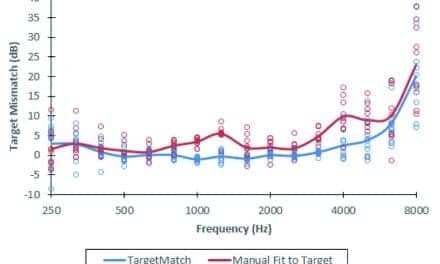A recent study1 by researchers from Boys Town National Research Hospital shows that Oticon OpenSound Navigator™ (OSN) improves children’s speech understanding in noisy environments when listeners directly face towards or face away from the principal talker, yet still preserves speech from other talkers in the environment, Oticon announced. The ability of OSN to preserve speech coming from different locations allows access to other talkers in the background, which is said to be fundamental to incidental learning in school-age children.
“Better speech recognition in noise even when the child is not facing the speaker is particularly important for children because spontaneous speech may come from any direction in typical learning environments and because children do not always turn in the direction of target speech,” explained Maureen Doty Tomasula, AuD, senior product & marketing manager, Oticon Pediatrics. “Giving children access to other talkers in the environment provides opportunities for incidental learning in everyday life.”
In the study, Boys Town researchers compared the signal-to-noise ratios required to achieve 50% recognition of speech in noise when OSN or omnidirectional setting (OMNI) was applied. Fourteen children (6-15 years of age) who were experienced hearing aid users listened to and repeated words presented from either directly in front of them or from the side. Competing noise or speech was presented from loudspeakers located to the back right and back left of the children.
The study results showed that OSN, relative to OMNI, improved speech recognition performance in competing noise by an average of 4.0 dB SNR (facing talker) and 3.8 dB SNR (facing away from talker). Similar performance was observed for OSN and OMNI in competing speech, indicating that OSN did not attenuate speech in the environment. These correspond to 20-30 percentage point improvements in speech recognition when comparing OSN to OMNI.
“The overall findings of the study were that children did benefit from OpenSound Navigator when the background noise was steady noise, and that was regardless of whether the children were facing the target talker of interest, or if the target was off to the side and they weren’t facing it,” said Jenna M. Browning, AuD, research audiologist, Center for Hearing Research, Boys Town National Research Hospital. “Either way, they did benefit and their signal-to-noise ratio was improved on average by about 4dB compared to an omnidirectional microphone.”
Open Sound Experience with Less Effort
In a separate study2 of listening effort for children with hearing loss (ages 12-16), researchers at VU University Medical Center, Amsterdam showed that OSN improves speech understanding with less effort compared to traditional OMNI. The results showed that OSN improved speech understanding across listening conditions by up to 5 dB SNR, compared to OMNI. Subjectively, the children perceived significantly less effort while listening to speech in noise with OSN activated.
For more information about OpenSound Navigator, watch a video interview with researchers from Boys Town Research Hospital and download the Benefits of Open Sound Navigator™ in Children tech paper
References
1. Browning J, Flaherty M, Leibold L, Buss E. Integrated directionality and noise reduction: Effects on children’s masked thresholds. Poster session presented at: The 44th Annual Scientific and Technology Conference of the American Auditory Society; March 2017; Scottsdale, AZ.
2. Oticon. Ng EHN, Goverts T, Kramer S, Zekveld A. Improved speech understanding with less effort in children: An OpenSound Navigator study. https://wdh.azureedge.net/-/media/oticon/main/pdf/master/whitepaper/31746uk_wp_amsterdam.pdf?la=en&rev=2989&hash=72528CE63C6BC01DD38CF0AF0398C26A90015D38. Published 2019.
Source: Oticon, Boys Town Research Hospital





